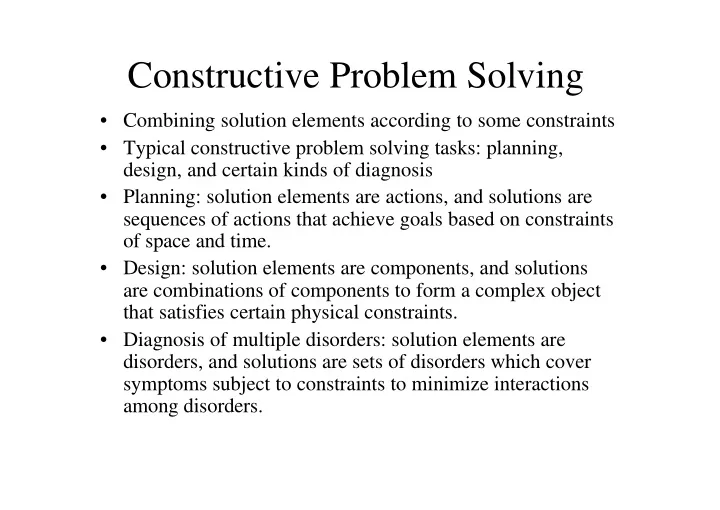

Constructive Problem Solving • Combining solution elements according to some constraints • Typical constructive problem solving tasks: planning, design, and certain kinds of diagnosis • Planning: solution elements are actions, and solutions are sequences of actions that achieve goals based on constraints of space and time. • Design: solution elements are components, and solutions are combinations of components to form a complex object that satisfies certain physical constraints. • Diagnosis of multiple disorders: solution elements are disorders, and solutions are sets of disorders which cover symptoms subject to constraints to minimize interactions among disorders.
R1/XCON • R1: a program that configures VAX computer systems by first checking the order is complete and then determining spatial arrangement of components. • XCON: commercial version of R1 • In contrast to MYCIN which is hypothesis driven, R1 is data driven • R1 is implemented in OPS5, a forerunner of CLIPS. • R1 needs two kinds of knowledge – About components – About constraints • R1 contains 10,000 rules, many of which deal with domain specific control knowledge
R1’s Configuration Subtasks • Check the order and rectify it, if necessary. • Configure the CPU • Configure the unibus modules • Configure the paneling • Generate a floor plan • Do the cabling
Contexts for imposing Task Structure • In addition to information about components and constraints, R1’s working memory contains context symbols to determine the order of subtasks. • Specificity Strategy: Rule 1 If: X is a bird and X is a penguin Then: X cannot fly dominates Rule 2 If: X is a bird Then: X can fly • MEA Strategy: Stresses the first condition of a rule when evaluating rule instantiation for possible execution.
MOLGEN • MOLGEN assists the geneticist in planning gene-cloning experiments in molecular genetics. The system uses knowledge about genetics and the user’s goal to create an abstract plan and then refines it to a set of specific laboratory steps. • MOLGEN adopts a multi-layered approach to construction problem with a Least Commitment Strategy. • MOLGEN uses three “planning spaces”, each with its own objects and operators, which communicate with each other via message-passing protocols.
MOLGEN’s Planning Spaces INTERPRETER Focus Strategy Resume Strategy steps space Guess Undo META-PLANNING Check-Prediction Design Refine-Operator Design steps space Propose-Goal PLANNING Sort Lab Screen Lab steps space Merge Transform
Constraint Operations in MOLGEN for Constructive Problem Solving • Constraint Formulation creates constraints that limit the solution space. • Constraint propagation passes information between subproblems which are almost independent of each other. • Constraint satisfaction pools constraints from subproblems as the details of the design are worked out.
Hierarchical Hypothesis and Test • Combination of heuristic classification and constructive problem solving • Combining solution elements into a composite hypothesis • Reasoning with an explicit taxonomic representation of the hypothesis space which is usually a tree whose leaves are solution elements • Beneficial when solution space is potentially very large • An example of hierarchical hypothesis and test: CENTAUR
CENTAUR • A reconstructed medical expert system from PUFF originally implemented in EMYCIN. • PUFF’s task is to determine presence of lung disease from measurements of amount of gas in the lungs and the rates of flow of gases in and out of the lungs. • CENTAUR contains a frame-like structure as representation of context for reasoning with production rules.
Frame Structure in CENTAUR PROTOTYPE: Obstructive Airways Disease . . . Superclass: Pulmonary-Disease . . . Subtype: Bronchitis . . . Severity: Moderately Severe Component 1 Name: Component 2 Range of values: . . . . Important measure: Component N Procedure: rule set Control: meta-knowledge Fact 1 . . . . Fact M
Rules Embedded in Prototypes • Prototype components represent domain specific object- level knowledge • Components are values of slots in the disease prototypes but they are prototypes in their own right • Thus prototypes are embedded in other prototypes • Also, rules are embedded in prototypes • Five kinds of rules in CENTAUR – Inference rules – Triggering rules – Fact-residual rules – Refinement rules – Summary rules
Network of Prototypes in CENTAUR CONSULTATION PULMONARY-DISEASE RESTRUCTIVE OBSTRUCTIVE DIFFUSION LUNG DISEASE AIRWAYS DISEASE DEFECT SEVERITY SUBTYPE MILD MOD MOD- SEVERE ASTHMA BRONCHITIS EMPHYSEMA SEVERE
Recommend
More recommend